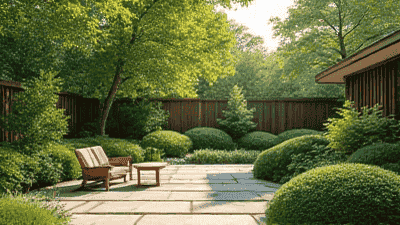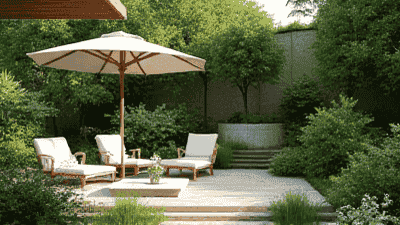
Sustainable landscaping is a vital component of creating outdoor spaces that not only enhance aesthetic appeal but also promote environmental harmony. As more individuals and communities recognize the importance of ecological practices, designing outdoor areas with sustainability in mind has become a priority.
Sustainable landscaping is an approach to designing and maintaining outdoor spaces that prioritize ecological health and resource conservation. It involves using practices that protect natural ecosystems, reduce waste, conserve water, and support biodiversity. Sustainable landscaping emphasizes the integration of native plants, organic practices, and resource-efficient designs that work with the environment rather than against it.
Incorporating sustainable landscaping practices offers numerous advantages:
Biodiversity: Sustainable landscapes support various plant and animal species, fostering a healthy ecosystem that enhances local biodiversity.
Water Conservation: By using native plants and implementing efficient irrigation systems, sustainable landscapes reduce water consumption and promote responsible water use.
Soil Health: Organic practices improve soil quality, leading to healthier plants and reduced reliance on synthetic fertilizers.
Carbon Sequestration: Plants absorb carbon dioxide, helping mitigate climate change. Sustainable landscaping maximizes vegetation to enhance this benefit.
Enhanced Aesthetics: Well-designed outdoor spaces can be visually stunning while also promoting environmental health, offering spaces for relaxation and recreation.

When designing outdoor spaces for environmental harmony, consider the following key principles:
Opt for native plants that are adapted to your local climate and soil conditions. Native plants require less water, are inherently pest-resistant, and support local wildlife, including pollinators such as bees and butterflies.
Implement practices that conserve water and capture rainwater. Efficient irrigation systems, such as drip irrigation or rain gardens, reduce water waste and promote healthy plant growth.
Focus on healthy soil practices, including composting, mulching, and organic amendments. Healthy soil retains moisture and nutrients, supporting robust plant life while reducing the need for chemical fertilizers.
Diversity in plantings creates a resilient ecosystem that can withstand pests and diseases. Incorporate a variety of species in your landscape to promote biodiversity.
Consider recycling materials in your landscaping project. Use reclaimed wood for garden beds, repurpose stones for pathways, or create compost from garden waste to enrich your soil.
Begin by assessing your outdoor area. Identify the existing features, such as trees, slopes, and sun exposure. Understanding your space will help you make informed design decisions.
Identify different microclimates in your landscape. Areas may receive varying sunlight, shade, wind exposure, and moisture levels. Recognizing these differences will help you select the right plants for each area.
Conduct a soil test to determine pH levels, nutrient content, and soil structure. This information is crucial for selecting appropriate plants and improving soil health.
Create a design plan that incorporates your goals and objectives for the space. Consider the desired functionality of the landscape, such as recreational areas, vegetable gardens, or native plant habitats.
Divide your landscape into distinct zones based on plant needs. Place sun-loving plants in sunny areas, shade-loving plants under trees, and moisture-loving plants in low-lying or wet areas.
Incorporate focal points such as ornamental trees, sculptures, or seating areas to create visual interest. Focal points draw the eye and provide spaces for relaxation and enjoyment.
Choosing the right plants is critical to sustainable landscaping. Focus on the following categories:
Research native plants that thrive in your region. Native species require less maintenance and contribute to local ecosystems. Consult local gardening resources or native plant societies for information.
Include flowers that attract pollinators, such as bees and butterflies. Plants like coneflowers, sunflowers, and milkweed provide vital food sources for these important species.
Consider incorporating edible plants such as vegetables, herbs, and fruit trees into your landscape. Edible landscaping promotes food security and reduces reliance on store-bought produce.
Effective water management is essential for sustainable landscaping. Employ various techniques to maximize water efficiency:
Create a rain garden to capture and absorb stormwater runoff. Rain gardens consist of native plants arranged in a patterned design that helps filter and retain rainwater.
Install drip irrigation systems to deliver water directly to plant roots. This method minimizes evaporation and ensures that plants receive adequate moisture.
Apply organic mulch around plants to retain soil moisture, suppress weeds, and improve soil health over time. Mulch also breaks down to add nutrients back into the soil.
Healthy soil is the foundation of a thriving landscape. Implement practices that improve soil quality:
Start a compost pile to recycle kitchen scraps and garden waste. Compost enriches the soil with nutrients and improves its structure, enhancing water retention.
Plant cover crops during the off-season to prevent soil erosion and improve soil fertility. Cover crops add organic matter and help suppress weeds.
Use organic soil amendments such as well-rotted manure, leaf mold, or bone meal to improve nutrient availability and overall soil health.
Promoting biodiversity is key to sustainable landscaping. Implement strategies that support diverse ecosystems:
Incorporate a mix of perennials, annuals, shrubs, and trees. A diverse planting palette provides habitat for wildlife and minimizes pest problems.
Create habitats for wildlife by incorporating features such as birdhouses, bat boxes, and insect hotels. These features provide shelter for beneficial creatures that support your garden ecosystem.
Implement natural pest management strategies, such as companion planting and attracting beneficial insects. Encourage predators such as ladybugs and lacewings to keep pest populations in check.
Minimize waste generation by incorporating recycled materials into your landscaping project. Implement the following ideas:
Use reclaimed wood for garden beds, upcycled bricks for pathways, and repurposed stones for borders. This approach reduces the demand for new materials while adding character to your landscape.
Recycle green waste from your garden by creating a compost system. Composting reduces waste sent to landfills and enriches your soil with organic matter.
Once your sustainable landscape is established, ongoing maintenance is essential:
Establish a routine for watering, pruning, weeding, and fertilizing. Regular care ensures that plants remain healthy and vibrant.
Keep track of soil health by periodically testing and amending as needed. Soil tests can reveal changes in nutrient levels and help you address issues early.
Observe how plants perform in your landscape. Some may thrive while others may need adjustments or replacements. Be willing to adapt your design based on observations over time.

Now that you have an understanding of sustainable landscaping principles and practices, here are some specific landscaping ideas to inspire your outdoor space design:
Create a native plant garden that showcases the flora of your region. Choose a variety of wildflowers, grasses, and shrubs that attract pollinators and support local wildlife.
Incorporate edible plants into your landscape design. Use fruit trees, berry bushes, and vegetable gardens as beautiful focal points while providing fresh produce.
Design a garden specifically for butterflies by planting nectar-rich flowers like echinacea, milkweed, and asters. Incorporate flat stones for basking and water sources for hydration.
Create a zen garden using gravel, rocks, and minimal plantings. This low-maintenance landscape promotes tranquility and relaxation while minimizing water requirements.
Establish perennial borders with a mix of flowering and foliage plants that bloom at different times throughout the year. This design adds continuous color and attracts beneficial insects.
Designate a section of your yard for a rain garden filled with moisture-loving plants. Use this area to manage stormwater runoff while enhancing aesthetics.
For small spaces, consider vertical gardening. Use trellises and wall-mounted planters to grow climbing vegetables, herbs, and flowers while maximizing your outdoor space.
Create a pollinator pathway that features diverse plantings to attract bees, butterflies, and hummingbirds. Include native plants with varying bloom times to provide continuous food sources.
If space permits, establish a community garden that encourages local residents to participate in gardening together. Community gardens enhance social connections while promoting sustainable practices.
Design pathways using permeable materials that allow rainwater to filter through the ground. Use stone, gravel, or reclaimed materials to create durable and eco-friendly walkways.
Designing outdoor spaces for environmental harmony is not only a reflection of personal style but also a commitment to sustainable living. By implementing the principles and practices outlined in this guide, you can create outdoor environments that promote biodiversity, conserve resources, and enhance the beauty of your surroundings.
Sustainable landscaping is a rewarding journey that contributes positively to the environment while providing enjoyment and fulfillment. Embrace the creative possibilities in landscaping, and take steps towards designing landscapes that harmoniously integrate with nature.